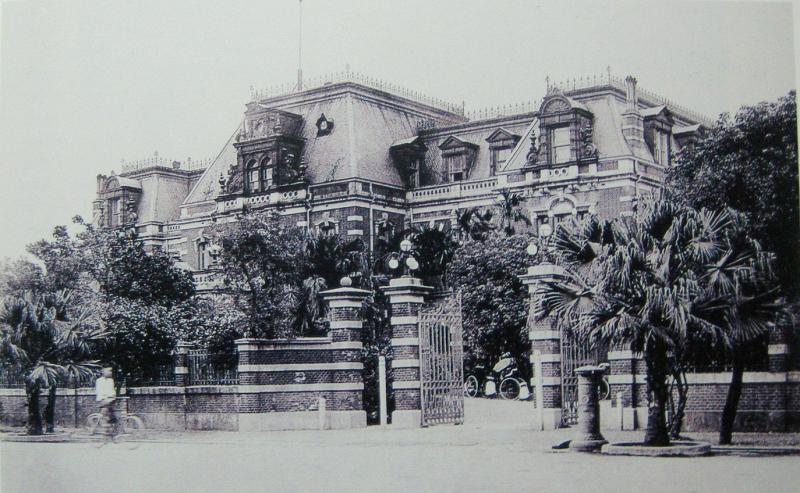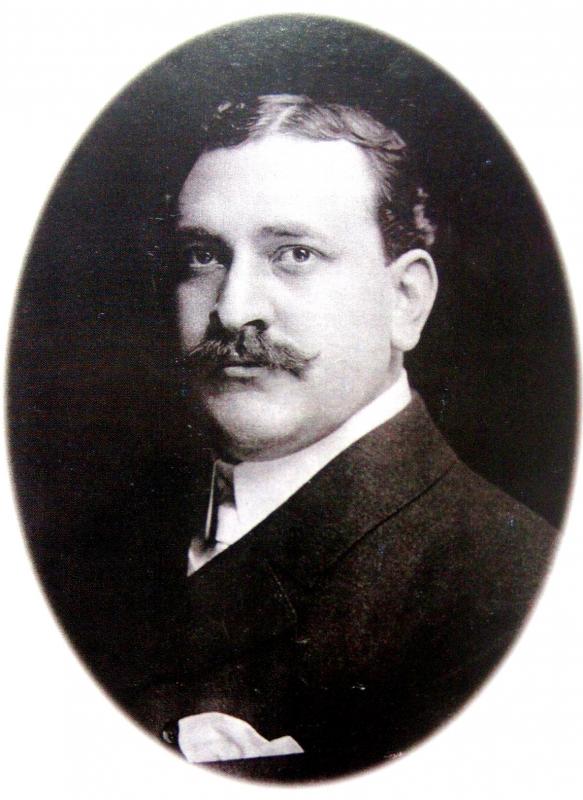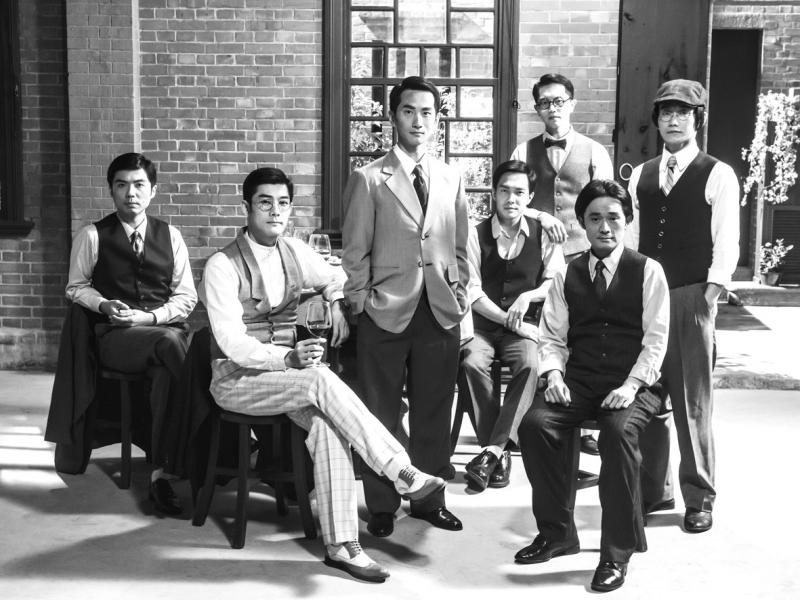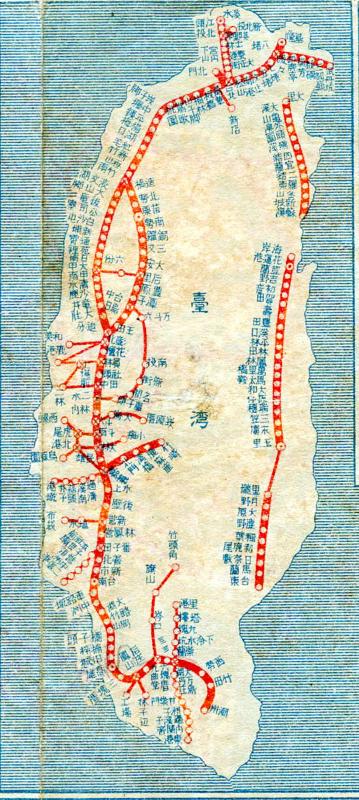Oct. 18 to Oct.24
To chief engineer Kinsuke Hasegawa, the completion of the Taiwan Railway Hotel was just as important as the launch of Taiwan’s first north-south railroad.
Many guests — most notably Japan’s Prince Kotohito — would be coming to Taiwan for the Western Trunk Line’s inauguration ceremony on Oct 24, 1908, and it was imperative to host them at the extremely lavish new establishment. Hasegawa personally presided over its construction for the final months, which carried on day and night with over 1,200 workers toiling in shifts.

Photo courtesy of Wikimedia Commons
They just made it — four days before the official ceremony. Designed by German-educated architect Tsumunaga Matsugasaki, the European-style, red-brick structure was Taiwan’s first Western hotel. Destroyed when the US bombed Taipei in 1945, it was located where today’s Shinkong Life Tower stands in Taipei.
The building resembled other notable colonial structures in the area, including the governor-general’s office, but it was reportedly the first to feature French-style mansard roofs, which frequently appeared on future government buildings. The hotel housed the nation’s first elevator, and boasted a bar, barber shop, reading room, tennis courts and a swimming pool.
Anyone could stay at the hotel, but its room rates limited customers to the wealthy and privileged. In 1935, only 5 percent of guests were Taiwanese, while 74 percent were Japanese and 21 percent foreigners. It never turned a profit, but the government poured money into it to keep it afloat, not only as a status symbol to show visitors the progress of the colony, but also as a popular venue for official events, banquets, conferences, exhibitions and artistic performances.

Photo courtesy of Wikimedia Commons
PURE LUXURY
Matsugasaki, a Japanese noble/royal, spent the bulk of his formative years in Germany. He was made a baron in 1884 after his return to Japan, and first became acquainted with Taiwan after designing former governor-general Taro Katsura’s residence.
It’s said that Matsugasaki’s unfamiliarity with the Japanese language impeded his career success in his homeland, and in 1907, he came to Taiwan to work for the colonial railroad department, which was on the verge of completing Taiwan’s first north-south railroad.

Photo courtesy of Green Film Production
He was much more prolific in Taiwan. In addition to the hotel, he also designed the railway stations in Keelung in 1912 and Hsinchu in 1913 — the latter still stands today. Another one of his existing works is Ximending’s Red House Theater, which he co-designed with Juro Kondo. His final project was the 1918 Taichung Assembly Hall, which was demolished in the 1980s.
Everything in the Taiwan Railway Hotel was top-notch. Under the management of Atsushi Fukushima, known as the “wizard of hotel management,” the hairdressers were trained at Tokyo’s Imperial Hotel and knew the latest Western hairstyles and beauty trends. The game room had both pool and billiards tables, and even employed a billiards instructor to teach guests.
Fukushima was immensely proud of the hotel’s Western-style restaurant, which featured European-trained chefs and a cellar full of top-shelf wine and spirits from across the world. The restaurant only used imported Canadian flour for its home-made bread and worked with government researchers to develop its own brand of soda. Patrons recall little details such as how the fruit was served with a little bowl of water for them to wash their hands with.

Photo courtesy of Wikimedia Commons
While most of the furnishings were imported, the rooms’ rattan chairs and wooden tables were made by inmates from the Taipei and Tainan prisons. The two deluxe suites cost 15 yuan per night, which was about half the monthly salary of a schoolteacher and was enough to feed a family of four for a month.
The hotel was not sustainable. It only achieved its opulence through government funding, and there would not be another official structure like this. The nation’s second railway hotel, established in Tainan in 1936, was much more modest.
WITNESS TO ACTIVISM
Noted anti-Japanese activist Lin Hsien-tang (林獻堂) was one of the few Taiwanese who regularly visited the hotel. He preferred to sleep in Taiwanese-run establishments in the Dadaocheng area, but he booked the railway hotel’s deluxe suite at least once. Many of the elite Taiwanese then were also political activists pushing for more autonomy, and the hotel witnessed its share of historic moments.
With Lin as a cofounder, the Taiwanese Assimilation Society was formed at the hotel in 1914. Boasting more than 3,000 members, the group called for equal treatment for Taiwanese and Japanese. The group invited civil rights activist Taisuke Itagaki, the founder of Japan’s first political party, to speak that year, also housing him in the hotel.
The completion of the railway made it much easier for the activists to spread their message, and the movement grew quickly despite the government shutting down the society in 1915.
In 1930, the Taiwan People’s Party (TPP) informed the League of Nations that the Japanese government was manufacturing and selling opium to Taiwanese. The league’s opium agents happened to be in East Asia, and they arrived in Taihoku (Taipei) on Feb 19.
The government tried to get on their good side by having them stay in the railway hotel, so the TPP sent all the incriminating evidence there. Despite government interference, on March 1, Lin and his colleagues met with the agents in the hotel.
This is one of the incidents that led to the government banning the TPP in 1931. A month after its demise, party cofounder Chiang Wei-shui (蔣渭水) visited Lin at the hotel to discuss the future direction of the movement. The two had fallen out earlier due to ideological differences, and the discussion went nowhere as Lin was still against Chiang’s leftist objectives.
The next day, the Japanese police visited Lin at the hotel, asking him if he and Chiang were planning on starting another party. Lin replied that his stay was purely business.
NOTABLE PATRONS
In addition to Prince Kotohito, the hotel hosted a number of prominent customers. It hosted another prince, Kuni Kuniyoshi (current emperor Akihito’s maternal grandfather), in 1928.
There were “rare guests with azure eyes,” including American aviator Art “Bird Boy” Smith, who arrived in 1916 as part of an Asian tour to show off his acrobatics. Smith’s performance inspired a then 16-year-old Hsieh Wen-ta (謝文達) to become the colony’s first Taiwanese aviator. In 1923, a group of 450 American tourists on a luxury cruise made a day trip from Kirun (Keelung) and dined at the hotel.
In 1926, the Japanese revealed the name of the new variety of rice they were growing in Taiwan in a ceremony at the hotel. “Ponlai rice, Ponlai rice,” then-head of the bureau of productive industries Katayama Saburo read twice on stage.
Explorer and businessman James W. Davidson, author of The Island of Formosa: Past and Present, stayed at the hotel in 1931 during his tour to promote Rotary International in East Asia. He made a presentation to prominent citizens during a luncheon at the restaurant.
The hotel hosted the founding ceremonies of two important art associations: the Taiwan Watercolor Society in 1927 and the Taiyang Art Research Association (台陽美術協會) in 1934.
After the original building's destruction, the Chinese Nationalist Party (KMT) reopened the hotel in a nearby building and ran it for several years. The Jinhua Hotel (金華飯店) and Shin Kong Life Insurance’s founding headquarters were built on the original site in 1963 .
Jinhua was replaced in 1973 by the Hilton Hotel (today’s Caesar Park Hotel), which was Taiwan’s first five-star international hotel.
Taiwan in Time, a column about Taiwan’s history that is published every Sunday, spotlights important or interesting events around the nation that either have anniversaries this week or are tied to current events.

The People’s Republic of China (PRC) last week offered us a glimpse of the violence it plans against Taiwan, with two days of blockade drills conducted around the nation and live-fire exercises not far away in the East China Sea. The PRC said it had practiced hitting “simulated targets of key ports and energy facilities.” Taiwan confirmed on Thursday that PRC Coast Guard ships were directed by the its Eastern Theater Command, meaning that they are assumed to be military assets in a confrontation. Because of this, the number of assets available to the PRC navy is far, far bigger

The 1990s were a turbulent time for the Chinese Nationalist Party’s (KMT) patronage factions. For a look at how they formed, check out the March 2 “Deep Dives.” In the boom years of the 1980s and 1990s the factions amassed fortunes from corruption, access to the levers of local government and prime access to property. They also moved into industries like construction and the gravel business, devastating river ecosystems while the governments they controlled looked the other way. By this period, the factions had largely carved out geographical feifdoms in the local jurisdictions the national KMT restrained them to. For example,

The remains of this Japanese-era trail designed to protect the camphor industry make for a scenic day-hike, a fascinating overnight hike or a challenging multi-day adventure Maolin District (茂林) in Kaohsiung is well known for beautiful roadside scenery, waterfalls, the annual butterfly migration and indigenous culture. A lesser known but worthwhile destination here lies along the very top of the valley: the Liugui Security Path (六龜警備道). This relic of the Japanese era once isolated the Maolin valley from the outside world but now serves to draw tourists in. The path originally ran for about 50km, but not all of this trail is still easily walkable. The nicest section for a simple day hike is the heavily trafficked southern section above Maolin and Wanshan (萬山) villages. Remains of

With over 100 works on display, this is Louise Bourgeois’ first solo show in Taiwan. Visitors are invited to traverse her world of love and hate, vengeance and acceptance, trauma and reconciliation. Dominating the entrance, the nine-foot-tall Crouching Spider (2003) greets visitors. The creature looms behind the glass facade, symbolic protector and gatekeeper to the intimate journey ahead. Bourgeois, best known for her giant spider sculptures, is one of the most influential artist of the twentieth century. Blending vulnerability and defiance through themes of sexuality, trauma and identity, her work reshaped the landscape of contemporary art with fearless honesty. “People are influenced by